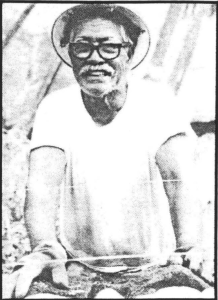Gabriel Ka'eo

A Social History of Kona
This project, a case study of Hawaii's social history, focuses on Kona where people nurtured the development of a community and participated in and witnessed some.of the major historical developments of the islands.
Gabriel Ka'eo, a native Hawaiian, was born on February 18, 1903, in Wai'ea, South Kana, Hawaii. His parents were Jones Emmanuel Ka'eo and Harriet Kamoku. Throughout his life, Gabriel lived in various places including Kealia, Hookena, Kana, and Honolulu. He held a variety of jobs such as a sugar plantation laborer, coffee picker, stevedore, contractor, and a stone wall builder. In 1926, he married Katherine Ka'ai and they had two children. As of the time of the interview in 1980, Gabriel was residing in Hookena.
Scope and Content Note
The interview with Gabriel Ka'eo, conducted by Larry L. Kimura, took place on December 17, 1980, and January 13, 1981, in Kealakekua, Kona, Hawaii. The interview was conducted in Hawaiian and later translated by Larry L. Kimura. The interview covers a wide range of topics, including Gabriel's birthplace and early life, his experiences living in different parts of Hawaii, and his various occupations. Gabriel also shares his memories of the local community, including a man named Ka'au'a who taught dancing and a postmaster named Mr. Lincoln who was a beautiful dancer along with his Hawaiian wife. Gabriel provides a vivid description of the local landscape, which was mostly grass and open, with Elli grass and 'ohi'a trees being the main plants. He also talks about the industrious nature of the Hawaiian people, including his grandfather who would walk from the beach to the mountains in a day, planting sweet potatoes and taro along the way. The interview also includes Gabriel's recollections of communal farming and food preparation practices, such as the collective peeling and pounding of taro into poi. He discusses changes in land ownership and the influx of retired haole (foreigners) building homes in the area. Finally, Gabriel talks about local schools, including the small Ala'e School and the Ho'okena School located near the beach.
Interview conducted in Hawaiian (translation)
Program Note:
This interview is part of the Center for Oral History's project A Social History of Kona. Interviews from this project are available in the Center's ScholarSpace open access repository.
The Center for Oral History (COH), in the Department of Ethnic Studies at the University of Hawaiʻi at Mānoa, collects, documents, preserves and highlights the recollections of Native Hawaiians and the multi-ethnic people of Hawaiʻi. It produces oral histories and interpretive historical materials about lifeways, key historic events, social movements and Hawaiʻi’s role in the globalizing world, for the widest possible use.
Please Note: The oral histories in this collection are protected by copyright and have been created for educational, research and personal use as described by the Fair Use Doctrine in the U.S. Copyright law. Please reach out Voices@noaa.gov to let us know how these interviews are being used in your research, project, exhibit, etc. The Voices staff can help provide other useful resources related to your inquiry.
The NOAA mission is to understand and predict changes in climate, weather, oceans, and coasts, to share that knowledge and information with others, and to conserve and manage coastal and marine ecosystems and resources. The Voices Oral History Archives offers public access to a wide range of accounts, including historical materials that are products of their particular times, and may contain offensive language or negative stereotypes.
Voices Oral History Archives does not verify the accuracy of materials submitted to us. The opinions expressed in the interviews are those of the interviewee only. The interviews here have been made available to the public only after the interviewer has confirmed that they have obtained consent.
